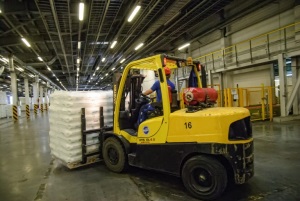Forklift feature articles
The largest forklift operator training website in the world
![]()
![]()

Carbon Monoxide and forklift trucks
This article, by Forklift Certification explains the hazards and precautions involved caused by carbon monoxide emissions on gas powered forklift trucks.
Forklifts are a vital part of most warehouse and distribution operations. However, driving these bulky vehicles carries a certain amount of risk. From blind spots to tip-overs, nearby pedestrians, and more, driving a truck demands constant attention to the hazards of the job. If you operate a forklift indoors, one hazard stands out from all the rest – carbon monoxide buildup. If overlooked, it can easily cause a fatality on the job.
Forklift carbon monoxide presents a real threat to those who operate a gas-powered truck. That’s why enforcing authorities treat it as a serious danger to the safety of forklift drivers. Their regulations and training guidelines focus on two main areas. One is how to identify the presence of carbon monoxide buildup. The other is how to prevent poisoning from this noxious gas.
This blog covers three key topics:
- The risks presented by high forklift carbon monoxide levels
- How to avoid carbon monoxide on the job
- Tips you can use in your daily forklift duties
But first, let’s take a crash course in what exactly carbon monoxide is.
Carbon monoxide is commonly referred to as CO. This means it is comprised of one carbon molecule and one oxygen molecule. According to the U.S. Environmental Protection Agency, carbon monoxide occurs when something is burned. This produces CO fumes that can be lethal in enclosed areas. Why is CO so dangerous? Because it is both colorless and odorless, making it hard to detect. Why is it lethal to humans? Because it robs the body of oxygen.
The air we breathe is 99% nitrogen and oxygen. The other 1% contains a small amount of other trace elements. Air with too much CO doesn’t have enough oxygen. Inhaling a large amount of CO reduces your body’s oxygen supply. As a result, the brain, lungs and other organs don’t get the oxygen they need to function properly. The effects of breathing CO include dizziness, severe headaches, nausea, and confusion. Too much CO can lead to unconsciousness and death.
Fossil fuel forklifts create carbon monoxide by burning fuel in an internal combustion engine. Some engines use gasoline in the USA. Others use diesel fuel. Most forklifts use a fuel-powered engine, but electric powered trucks are also common. Thus, carbon monoxide and forklifts aren’t going away anytime soon. That can be a fatal combination.